Introduction
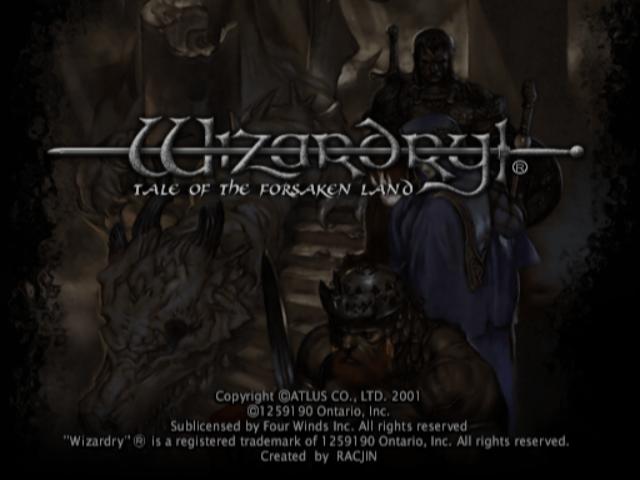
Welcome, everyone, to Let's Play Wizardry: Tale of the Forsaken Land! I'm your host, Miketopus, only recently recovered from a slog through the 1985 DOS version of The Bard's Tale. And yes, I plan to brag about this as much as I can.
Also known as Busin: Wizardry Alternative in Japan, this game is a non-linear installment in the Wizardry series. It boasts traditional turn-based combat, stats and leveling, and several other classical aspects of Wizardry and RPGs in general. However, it boasts very detailed graphics, visual novel-style cutscenes, and several other very unusual features to separate it from the pack.
This is probably only the second time I've LPed a game I actually liked quite a bit. In my opinion, it's hard to go wrong with Atlus, and this is an example of a modern RPG done right. Just enough bells and whistles to entertain without going overboard, and enough challenge without overwhelming most players. Well... for the most part, anyway. And the soundtrack and cinematics are beautiful - I fully intend to make use of them throughout the LP in music and video installments wherever possible.
Here's the introduction to this harrowing tale of love, hate, and violence: http://www.youtube.com/watch?v=i0b472KSWDA

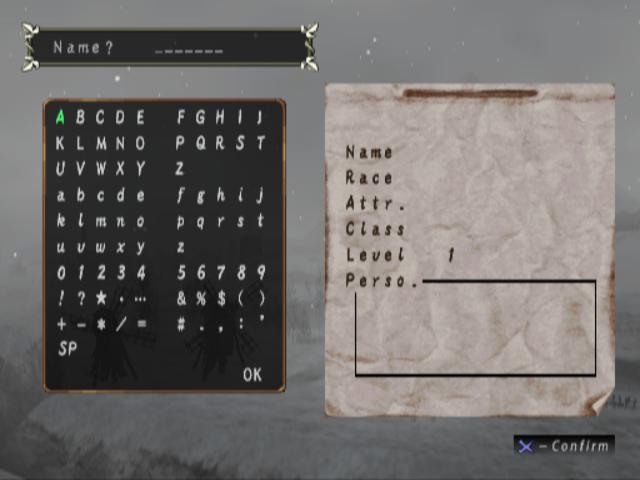
I'm going to use mostly NPCs for our party, but our main character is a blank slate. I'm going to draw upon the goon community to come up with something good! First, we start with a name. Just so you know, there's no possibility of gender differentiation for the main character; there's a lot to indicate that the main character is male, but you never actually see them in-game. So, go nuts!
"A race is one of five races that exist in this world. Each race has a distinctive specialty, such as dwarves who excel in strength and elves who are masters of spells."
I'm going to list each of the racial templates on here, along with their starting stats. Keep in mind, races do not disqualify characters from classes in this game.
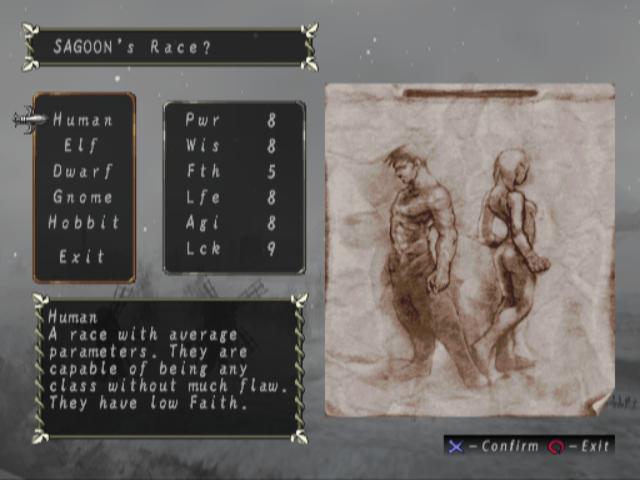
Humans are, as usual, well-rounded characters who can do well in practically any class.
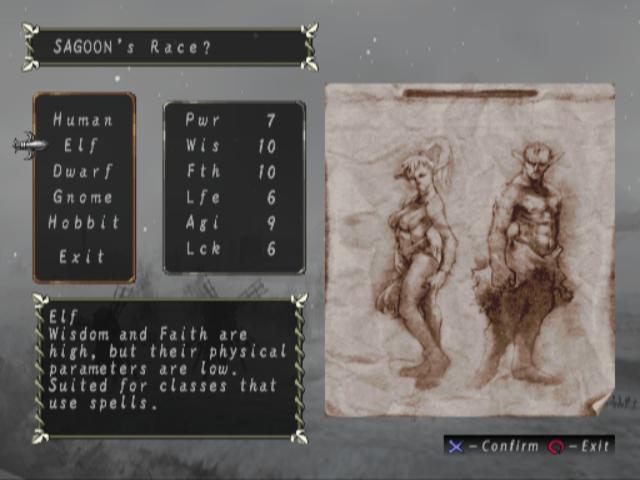
Elves can do well as sorcerers, priests, or bishops. They would also make half-decent thieves if their luck wasn't so horrible.
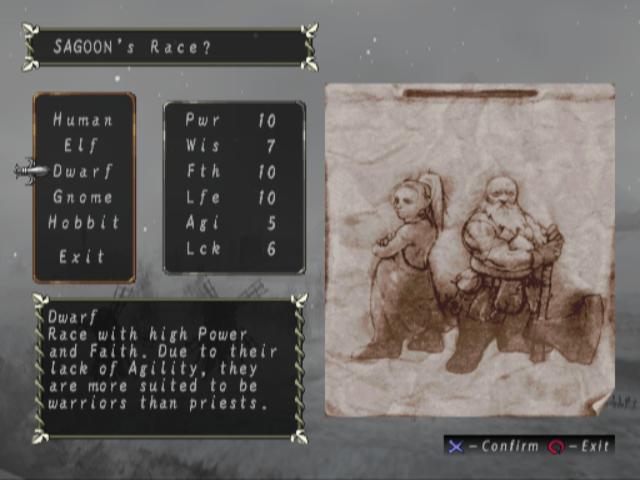
Dwarves make excellent warriors, okay priests, and awesome knights.
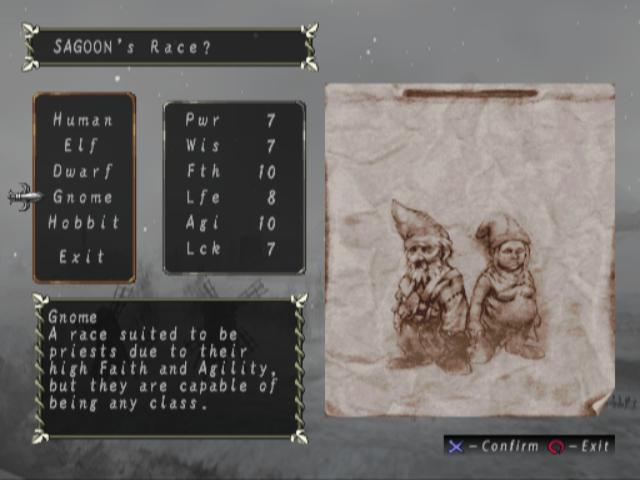
Gnomes make really good priests, for some odd reason.
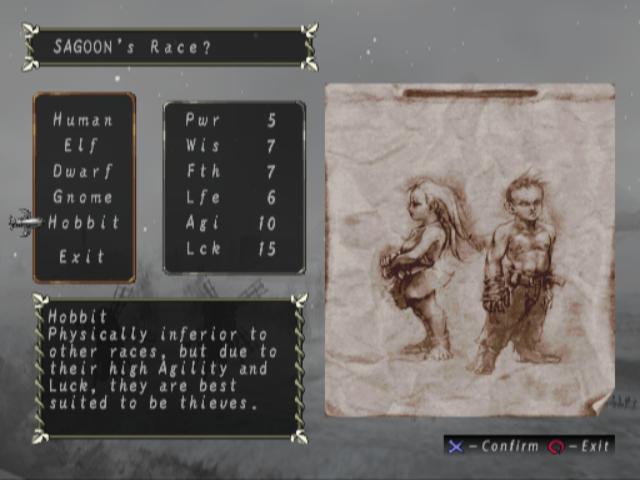
Hobbits are... yeah. Pretty much just thieves. Hobbits are also good ninjas. Never thought I'd say that out loud.
"An attribute is the tendency of certain actions that a being will take. There are three major attributes that can clash with each other."
This is the classical alignment system, basically. Acting against your alignment repeatedly can change it, so be careful.
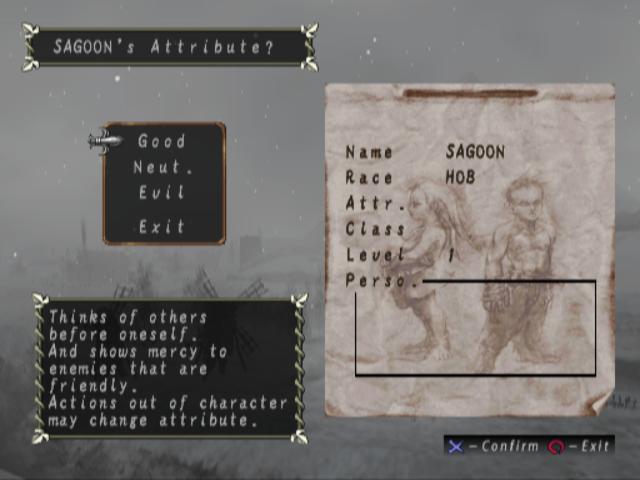
Good-aligned characters are pretty straightforward. When you have the choice to be nice in-game (Letting friendly monsters go, being kind to NPCs, etc.), you should take the benevolent route whenever possible to raise trust.
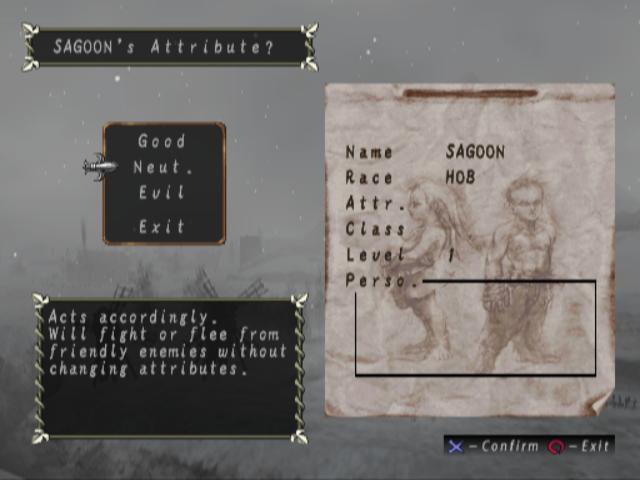
Neutral characters can do whatever they wish, as long as they aren't too overly good or evil. The big advantage to being neutral is that you can recruit NPCs from either end of the alignment pool and get along with them marginally well. But, it's best to keep to one side or the other. For example, if you have a few good-aligned NPCs, keep your party staffed with neutral and/or good party members.

As always, evil characters are basically giant assholes. It's hard to build trust in an evil party, since you can't show any mercy or kindness. Evil alignment has two distinct advantages, however: Ninjas and rare equipment. Ninjas can only be evil normally, and there's some very powerful stuff that can only be used by evil characters. Still, is it really worth it?
"Every character has a hidden talent that relates to their class. Battling strategies will differ depending on their class. There are several classes such as those who handle swords, spells, etc."
Alignment can affect what classes are available to us, so you'll want to pick a class to go with the alignments. I'll give you a bit more detail on what each class is good at and what it can lead to. Here's what each alignment can pick from:
Good:
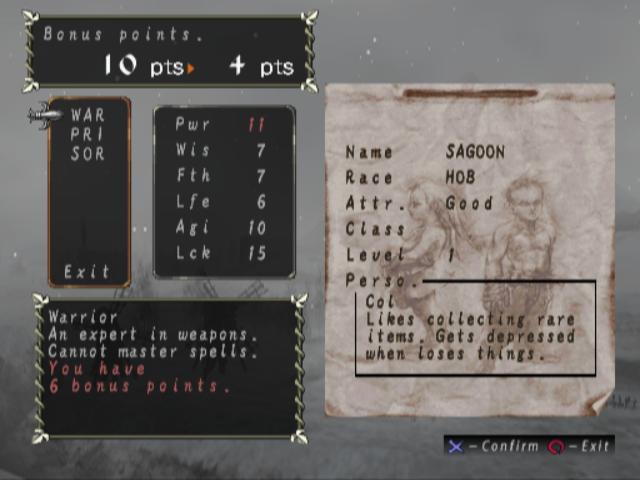
Neutral:
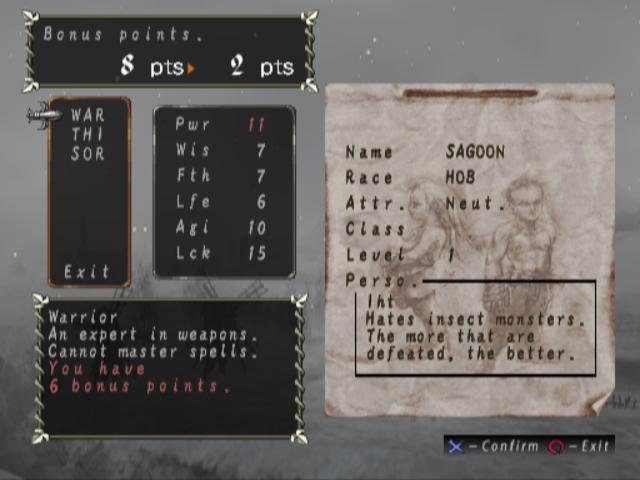
Evil:
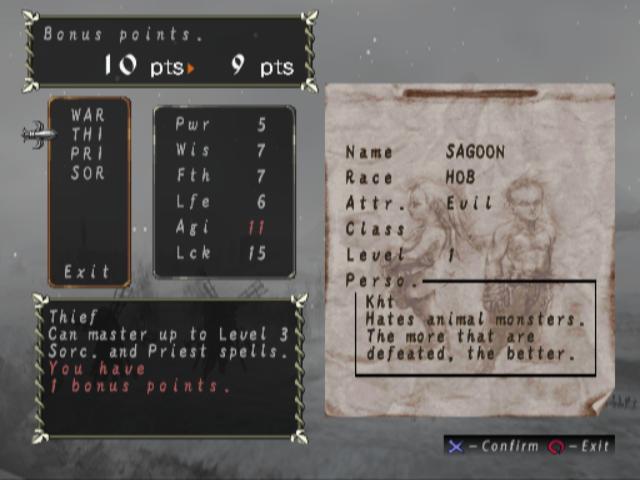
And now, let's talk about the classes themselves.
Warrior: "An expert in weapons. Cannot master spells."
Basically, the warrior fills the same niche as always - brute force. They can use nearly every weapon in the game, except for specialty weapons like katanas, and they have a good selection of armor and such too. You can eventually upgrade to two classes from warrior naturally: Knight and Samurai.
Priest: "Can master all Priest spells."
Priests are primarily healers, but they're also good at enhancing party stats through buffs. They can also do some damage with spells, and turn undead. Priests can eventually change class to Bishop, but there's not much point in doing so. Priests can be good or evil, but not neutral.
Sorcerer: "Can master all Sorcerer spells."
Sorcerers specialize in doing damage with their magic. They can also upgrade to Bishop, but again, not recommended.
Thief: "Can master up to level 3 Sorc. and priests spells."
Thieves don't get very many perks. Their equipment isn't that great, and their magic isn't too good either even though they have the option. They can disarm traps, however, which is vital to surviving in this game. It is also rumored by certain goons (Koorisch!) that rare item drop rates increase when you have a thief. So, it's easier to get good stuff. As you may have noticed, a "natural" thief can only be neutral or evil. I say "natural" because there's ways to circumvent this restriction. Thieves can eventually upgrade to Ninja.
Knight: Knights can use priest spells up to level 6. They have pretty shoddy evasion and speed, but their equipment, especially their armor potential, is top notch, and their strength is among the best. Knights can only be good-aligned.
Samurai: Samurai can use sorcerer spells up to level 6. Their speed, attack, and stats are all around badass. They can also use katanas, which are exclusive to them. If that weren't awesome enough? When they get a critical hit, they instantly kill the enemy. Good or neutral alignment. One of my favorites, obviously.
Bishop: Bishops can use both priest and sorcerer spells without any problems, but they aren't quite as good at either as a priest or sorcerer. They can also identify unknown items, which is okay. Their equipment selection is better than a sorcerer, but worse than a priest. Like priests, they can't be neutral.
Ninja: Ninjas are, put simply, your best friend and your worst enemy. Naturally, they're ridiculously quick and have high evasion. They can use up to level 2 sorcerer and priest spells, but they are terrible at both. Their equipment selection is about the same as thieves. They can disarm traps, too, which already makes them better than thieves in every aspect. They also share the samurai's ability to instantly kill with critical hits, but they do it much more often, and they can do so either close up or with ranged weapons. Goon-lore (Courtesy of Tallgeese) suggests that ninjas share the thief's rare item drop rate increase, but to a lesser extent. Ninjas are evil-aligned only, with the exception of at least one NPC in the game.
Changing Classes: Later on in the game, it is possible to change your class through one of two ways: You must either go to the Guild and qualify for the class change (Minimum stats are required for each class, as well as alignment restrictions on occasion), or you must use an item that changes your class.
Going to the Guild is by far the cheaper option, but doing so resets the character to a certain default level. For example, a new samurai starts at level 8, so you must be at least that high a level and meet the other stat requirements for the class. You can also buy class changing orbs. Not only does the character keep their levels, but they also bypass stat and alignment restriction. For example, a Bishop normally needs to be Good or Evil, but a bishop orb would allow a Neutral character to become one anyway. There's also items for changing alignment, which is another way to bend the rules if you don't want to shell out 70,000 gold for a class change orb. We'll see more about this in chapter 5.
...Still with me? We're almost done! All we have to do now is spread out our stats. I'll handle this part, so let me just tell you what each one means and we'll wrap this up.
Power (Pwr) - "Affects damage, with weapons, on enemies."
Wisdom (Wis) - "Affects the degree of ease in casting and resisting a Sorcerer spell."
Faith (Fth) - "Affects the degree of ease in casting and resisting a Priest spell."
Life (Lfe) - "Affects the resistance to poison and paralysis, and the ease of revival from death."
Agility (Agi) - "Affects the speed of actions during battle."
Luck (Lck) - "Affects the resistance to Breath and is used in other situations."
Pretty self-explanatory. Races have certain bonuses and penalties to these stats, which you can review above. We're given a set of bonus points to spread out however we wish, as well - this ranges from about 7 to 10 randomly.
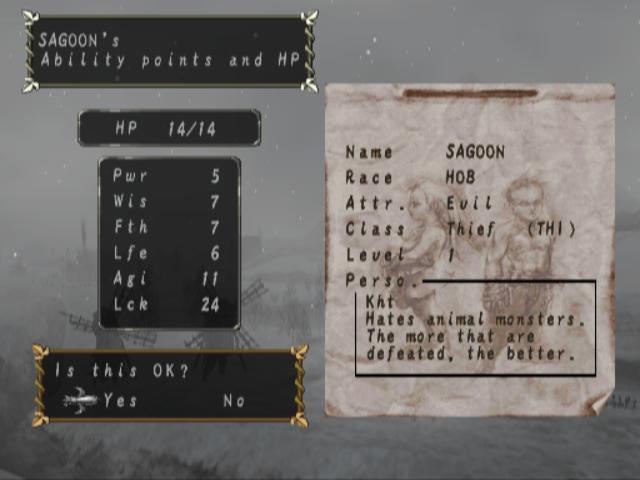
This is just an example of how a finished character looks. But, everyone knows an SA goon can't be that lucky, so start sending in your suggestions! Try to format it something like this:
Name
Race
Alignment
Class
Oh, and that "Perso" window on the right side of the screen is randomly generated based on alignment. It's part of how your main character raises trust, which is very important but largely out of our control. Don't worry, we'll get into all that later.
Duhan awaits, everyone! I look forward to exploring this game with everybody!
Table of Contents
- Chapter 1-1: Exposition, Exposition, Exposition
- Chapter 1-2: The Ninja and the Warrior
- Chapter 1-3: The Snowy Altar
- Chapter 1-4: Allied Actions
- Chapter 1-5: Oddjob(s)
- Chapter 1-6: Ice Queen
- Chapter 2-1: Rui
- Chapter 2-2: The Reaper
- Chapter 2-3: Get Out of Jail Free
- Chapter 3: Femme Fatales
- Chapter 4-1: Grave Misfortunes
- Chapter 4-2: Kulgan the Agile
- Chapter 4-3: Orphe Bright
- Chapter 5-1: The Waterfall
- Chapter 5-2: Barfo's Revenge
- Chapter 5-3: Quests, With a Side of Quests
- Chapter 5-4: Raising an Army
- Chapter 5-5: Michele
- Chapter 5-X: That Damn Priest!
- Chapter 6-1: Orphe and Aoba
- Chapter 6-X: Helga
- Chapter 6-2: Incubus, Demon of Dreams
- Chapter 6-3: Family
- Chapter 7: Confrontations
- Chapter 8-1: Lord of the Undead
- Chapter 8-2: The Emotions of the Earth
- Chapter 8-3: Sagoon
- Chapter 8-4: The Flash
- Chapter 8-5: Sophia
- Chapter 9: Return of the Barfo
- Chapter 10-1: Virgo
- Chapter 10-2: Don't Fear the Reaper!
- Chapter 11-1: Final Requests
- Chapter 11-2: Dimension World
- Chapter 11-3: Bu'Shin
- Chapter EX-1: The Abyss
- Chapter EX-2: Loose Ends